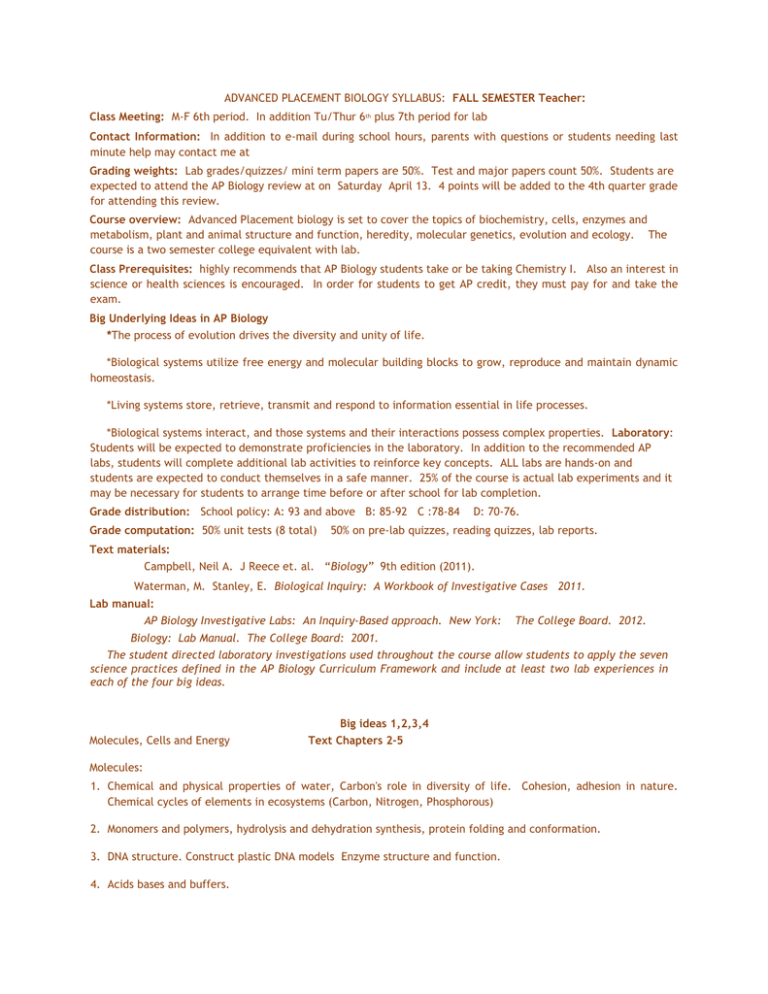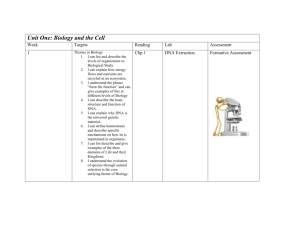ADVANCED PLACEMENT BIOLOGY SYLLABUS: FALL SEMESTER
advertisement

ADVANCED PLACEMENT BIOLOGY SYLLABUS: FALL SEMESTER Teacher: Class Meeting: M-F 6th period. In addition Tu/Thur 6th plus 7th period for lab Contact Information: In addition to e-mail during school hours, parents with questions or students needing last minute help may contact me at Grading weights: Lab grades/quizzes/ mini term papers are 50%. Test and major papers count 50%. Students are expected to attend the AP Biology review at on Saturday April 13. 4 points will be added to the 4th quarter grade for attending this review. Course overview: Advanced Placement biology is set to cover the topics of biochemistry, cells, enzymes and metabolism, plant and animal structure and function, heredity, molecular genetics, evolution and ecology. The course is a two semester college equivalent with lab. Class Prerequisites: highly recommends that AP Biology students take or be taking Chemistry I. Also an interest in science or health sciences is encouraged. In order for students to get AP credit, they must pay for and take the exam. Big Underlying Ideas in AP Biology *The process of evolution drives the diversity and unity of life. *Biological systems utilize free energy and molecular building blocks to grow, reproduce and maintain dynamic homeostasis. *Living systems store, retrieve, transmit and respond to information essential in life processes. *Biological systems interact, and those systems and their interactions possess complex properties. Laboratory: Students will be expected to demonstrate proficiencies in the laboratory. In addition to the recommended AP labs, students will complete additional lab activities to reinforce key concepts. ALL labs are hands-on and students are expected to conduct themselves in a safe manner. 25% of the course is actual lab experiments and it may be necessary for students to arrange time before or after school for lab completion. Grade distribution: School policy: A: 93 and above B: 85-92 C :78-84 Grade computation: 50% unit tests (8 total) D: 70-76. 50% on pre-lab quizzes, reading quizzes, lab reports. Text materials: Campbell, Neil A. J Reece et. al. “Biology” 9th edition (2011). Waterman, M. Stanley, E. Biological Inquiry: A Workbook of Investigative Cases 2011. Lab manual: AP Biology Investigative Labs: An Inquiry-Based approach. New York: The College Board. 2012. Biology: Lab Manual. The College Board: 2001. The student directed laboratory investigations used throughout the course allow students to apply the seven science practices defined in the AP Biology Curriculum Framework and include at least two lab experiences in each of the four big ideas. Molecules, Cells and Energy Big ideas 1,2,3,4 Text Chapters 2-5 Molecules: 1. Chemical and physical properties of water, Carbon's role in diversity of life. Cohesion, adhesion in nature. Chemical cycles of elements in ecosystems (Carbon, Nitrogen, Phosphorous) 2. Monomers and polymers, hydrolysis and dehydration synthesis, protein folding and conformation. 3. DNA structure. Construct plastic DNA models Enzyme structure and function. 4. Acids bases and buffers. LAB: Ball and stick models of macromolecules. LAB: Acid, base, buffer Lab: cubes and balloons for surface area calculations lab udent centered enzyme catalysis lab, Investigative lab #13. LAB: St LAB: Using indicators to identify proteins, carbohydrates and lipids in foods. Cells 1. Structure and function, compare and constast prokaryotic and eukaryotic cells. Endosymbiosis and serial endosymbiosis. Characteristics of all eukaryotes. (cytoskeleton, linear chromosomes, endomembrane systems.) 2. Cell membrane structure and function, methods of transport across cell membranes. Surface area to volume calculations. Ex: villi and microvilli. Active and passive transport. EX: Sodium and potassium transport. Transport proteins, glucose transport. 3. Chapter 11 detailed. Cell communication, stages of cell signaling, signal transduction pathways, hormones. Examples of cell to cell communication and hormone to cell communication. 4. Apoptosis (programmed cell death) and its role in normal development and differentiation. Illustrative example: morphogenesis of fingers and toes. 4. Cell energy: ATP structure and function, ATP synthase, basic energetic chemical equations. (glycolysis, citric acid cycle, electron transport chain and chemiosomosis, chemosynthetic prokaryotes. Role of NADP and FADH2 5. Cells response to temperature changes. EX: pyrogens. Cells response to surroundings. EX: qurom sensing and biofilms. 6. Enzyme catalysis and energy of activation. 7. Photosynthesis: light and dark reaction. Compare photosynthesis and respiration. Role of NADP and ATP in photosynthesis. Lab: Construction of cubes and calculation of volume to surface area ratios. Inquiry lab 4: Diffusion and Osmosis Investigative lab 6: Cellular respiration Prelab: toothpickase Investigatice lab 13: Enzyme Activity Investigative Lab 5: Photosynthesis ASSESMENT: Reading quizzes, Student generated concept maps such as comparisons of DNA and RNA structure, "Yellow Book" past AP Biology exam questions, Unit test with essay component. Big Ideas 1 and 3: Heredity, Genetics. Text chapters 13-21 1. Mendelian genetics: patterns. Genetic crosses. patterns of inheritance. Exceptions to classical Mendelian genetics inheritance 2. Chromosomes. Mitosis (including the cell cycle) and Meiosis. Thomas H Morgan and Drosophilia genetics including sex linkage and linked genes. Ding dong plant problem. How meiosis and crossing over introduce variation into a population. Bozeman videos on mitosis and meiosis. 3. Assign reports on experiments historical experiments that confirmed the central dogma. (Griffith, Watson, Crick, Wilkins and Franklin, Avery-MacLeod- McCarty, Hershey-Chase) DNA Structure and semi conservative replication. RNA structure, exceptions to the Central Dogma including transposable genetic elements, Protein synthesis (transcription and translation) Mutations and their role in natural selection. Bozeman videos: DNA and RNA part 1 and 2. 4. The genetics of viruses and bacteria. Lytic and lysogenic cycles, transduction, transformation, Regulation of gene expression in bacteria, the lac operon. Histone acetylation and deacetylation. 5. "Modern" molecular genetics and biotechnology. Recombinant DNA with review of transformation. PCR, Gel electrophoresis. Introduction of BLAST to analyze genomes. Lab: Model mitosis using clay. Page S 83 in new lab book. Crossing over with pop beads. Lab: DNA plastic models. DNA extraction of onion or strawberry cells. Lab 8: Bacterial transformation. Lab 9: Restriction enzyme analysis and gel electrophoresis of a glo/ ampicillin resistant plasmid. Lab: face lab ASSESSMENT: Reading quizzes, Student generated concept maps such as comparisons of DNA and RNA structure, "Yellow Book" past AP Biology exam questions, Unit test with essay component. SPRING SEMESTER BIG IDEA 1: The process of evolution drives the diversity and unity of life. TEXT CHAPTERS 22-26. 1. Darwin's explorations on the HMS Beagle and theory of decent with modification and natural selection. Nova Film: “What Darwin Didn’t Know,” 2. Evidence for evolution (morphological and molecular). Brief survey of the fossils and dating fossils. 3. Evolution of populations. Castle, Hardy, Weinberg equilibrium theory. 4. geographic barriers, pre and post zygotic mechenisms, gene flow, modes of selection (p. 401). Sexual selection, heterozygote advantage, frequency dependent selection. 5. Early life on Earth. Endosymbiosis theory, evolution of prokaryotes and eukaryotes. Experiments of Miller, et al. organic soup hypothesis, Extinction episodes, RNA World hypothesis 6. The impact of geological and meteorological events on ecosystem distribution. Alverez and Alverez impact hypothesis, continental drift. Biogeography and Island biogeography. 7. Phylogenetic trees and cladograms. rRNA commonalities. Glycolysis as a universal process. Vestigial structures, homologous structures. 8. The effect on environment of gene expression. Height, weight and nutrition in humans, flower color based and soil pH. READINGS: p. 461-62. The evolution of drug resistant bacteria. P. 475. Conditions for Hardy-Weinberg Equilibrium. P. 470, variations within populations. p. 471, variation between populations) Genetic drift page 477. Founder effect retinitis pigmentosa 477-78. Bottleneck effect in prairie chicken pp.478-79. Allopatric speciation in snapping shrimp p.494. Sympatric speciation of sexual selection in ciclids p.497. a. LAB INVESTIGATION 2: Mathematical Modeling: Hardy-Weinberg b. LAB INVESTIGATION: Heterozygote advantage. P. 95 in 2001 lab book c. LAB 3: Analyzing genes with BLAST; Using data to construct phylogenetic trees. ASSESSMENT: Reading quizzes, Student generated concept maps such as comparisons of DNA and RNA structure, "Yellow Book" past AP Biology exam questions, section tests. Big ideas 1,3 and 4: Organisms and Populations Plants and their diversity. TEXT CHAPTERS: 35-39. 1. Adaptations needed for plants to colonize land. Students will connect the enduring understanding within big idea one with animal adaptations for land. Cell walls, Plant transport, role of xylem, pholoem, plasmodesmata, structure and function of chloroplasts, photosynthesis and photosystems. Gas exchange in aquatic and terrestrial plants. 2. Evolution of seed plants, Life history strategies, perennial, biennial and annual. 3. Structure, growth and development. Revisit plant cell wall composition and plasma membrane function. 4. Plant responses to internal and external stimuli. Chemical plant defense mechanisms local and systemic, plant response to water stress, ripening of fruit, leaf abscission, photoperiodism in plants 5. Nutritional adaptations of plants. (mutualism, parasitism and commensalism involvement in plants) 6. Flower anatomy and angiosperm reproduction (double fertilization). Insect pollinators, flower coloration. LAB: Flower dissection LAB: Transpiration. Investigative lab number 11 READINGS: photoperiodism in plants, p. 839-840. Phototropism in plants 825-26. p. 740 evolutionary adaptations of roots, p.741 evolutionary adaptations of stems, p. 742 evolutionary adaptations of leaves, p. 776-78 the entire section 36.4. p.779-80 movement from sugar sources to sugar sinks. ASSESSMENT: Section test, practical test on plant specimens, student generated concept maps, Unit test. Big ideas 1,3 and 4: Organisms and Populations Animal diversity. Text Chapters 32-34 and 40-49. Chapter 11. 1. Characteristics and body plans of invertebrates as you go up the phylogenetic tree. Endothermy and ectothermy. (countercurrent exchange mechanisms) Relation between size of an organism and metabolism. 2. Basic anatomy principles. 3. Analysis of structure and function of body systems. (Emphasize endocrine, nervous and immune. Revisit cell surface and volume ratios. Flinn sweet 16 cell bracket. Enzyme lab. 4. Homeostatic mechanisms in animals: gas exchange in aquatic and terrestrial animals, nitrogenous waste production and elimination (excretion) in aquatic and terrestrial animals, survey of excretory systems, diabetes mellitus and glucose regulation. 5. Structure of the neuron, signal transduction and action potentials, Synapses and neurotransmitters. Illustrative example: Acetylcholine. Stimulatory and inhibitory responses. Cell to cell signaling and short and long distance signaling. a. Different regions of the vertebrate brain have different functions. Illustrative examples: neuro-hormone production. Vision, hearing, cerebrum, brainstem, cerebellum 5b. Immune cells interact by cell to cell contact. Innate vs acquired immunity, self vs non self (blood clotting), histamine response. 5c. Invertebrates lack specific responses, cell mediated vs humoral, antigen presentation, role of apoptosis in immune response. antigen and antibody responses, immune system memory capacity. Immune response to toxins, pathogens, allergens. Chapter 11, some local and long distance signaling. 5d. Revisit quorum sensing in bacteria. 5e. Longer distance signaling: Insulin and Estrogen 6. Physiological responses by animals to internal and external cues. Hibernation, estivation, migration. Dirurnal and nocturnal sleep wake cycles. READINGS: Balancing heat loss and heat gain, p. 864-68. Positive feedback, lactation and the onset of labor in childbirth p. 982. Maintainence of glucose and glycogen levels, p. 982. Type I and Type II diabetes, p. 983, The role of ADH in the dehydration response 969-970, Hibernation and migration in animals 872. ASSESSMENT: Reading quizzes, "Yellow Book" past AP Biology exam questions, Unit test with essay component. MILTIMEDIA: HHMI lecture 3 on “The “Science of Fat” Big idea 1, 3, 4 Organisms and Populations: Ecology Text Chapters: 50-55 1. Interaction of biotic and abiotic factors, predator prey relationships 2. Communities and ecosystems, energy flow, food chains/webs, niche and resource partitioning, cycles, evolution of symbiosis. 3. Animal behavior and communication. characteristics of eusocial animals. Bee dances, territorial marking, aposematic behavior, 3. Population dynamics, population density, revisit the evolution of emergent diseases, small pox and the Columbian exchange. 4. Human impact on ecosystems. Introduced or invasive species (the Argentina fire ant) Revisit DDT resistance in insects. Loss of keystone species and impacts of their removal. LAB: Animal behavior: Leaf choice study of the Eastern Tent Caterpillar, AND/OR Investigative 12: Fruit fly behavior. LAB: Dissolved oxygen and primary productivity. ASSESSMENT: Reading quizzes, Student generated concept maps, "Yellow Book" past AP Biology exam questions, Unit test with essay component. AP BIO PREP VARSITY LEARNING TOOLS.





